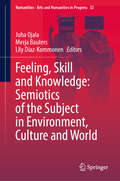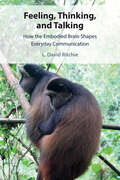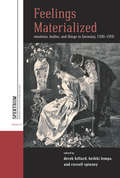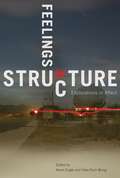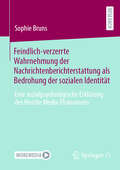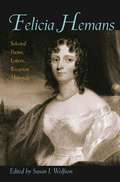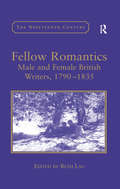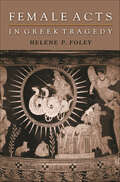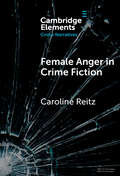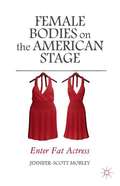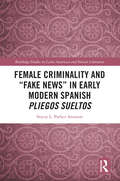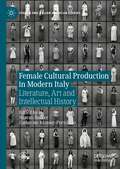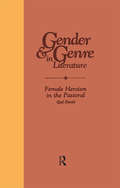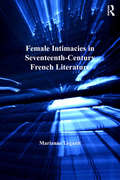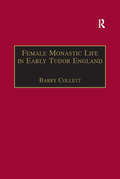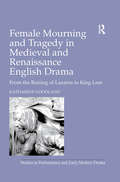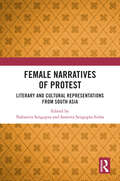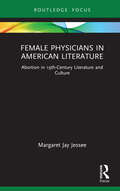- Table View
- List View
Feeling, Skill and Knowledge: Semiotics of the Subject in Environment, Culture and World (Numanities - Arts and Humanities in Progress #32)
by Merja Bauters Juha Ojala Lily Díaz-KommonenMarketing text: This edited volume includes contributions from scholars worldwide addressing how feeling, skill, and knowledge are present in the processes of signification, the subject&’s life, environment, and culture. Understanding signs, signification and their dynamics are now more crucial than ever as meaning affects how human beings flourish in social systems and societies. This text focuses on how theories and research into meaning and signification address knowledge, skill, and feeling – three concepts that are central to semiosis. The book is primarily of interest to scholars and students working in psychology, philosophy, communication, cultural studies, the arts – and semiotics.
Feeling, Thinking, and Talking: How the Embodied Brain Shapes Everyday Communication
by L. David RitchieThe way the brain, body, and mind interact with social structure to shape communication has so far not received the attention it deserves. This book addresses this gap by providing a novel account of communication as a social, biological and neurological force. Combining theories from communication studies and psycholinguistics, and drawing on biological and evolutionary perspectives, it shows how communication is inherently both biological and social, and that language and the neural systems that support it have evolved in response to a complex social environment. It introduces a clear set of terms based on current research, and illustrates key concepts using real-life examples from everyday conversation - speaking to a number of current debates around the evolutionary and biological basis of language, and the relationship between language, cognition, and environment. Thought provoking and engaging, it will change the way we think about the relationship between communication and cognition.
Feelings Materialized: Emotions, Bodies, and Things in Germany, 1500–1950 (Spektrum: Publications of the German Studies Association #21)
by Derek Hillard Heikki Lempa Russell SpinneyOf the many innovative historiographical approaches to emerge during the twenty-first century, one of the most productive has been the nexus of theories and methodologies broadly defined as “the history of emotions.” While this conceptual toolkit has generated significant insights into the past, it has overwhelmingly focused on emotions as linguistic and semantic phenomena. This edited volume looks instead to the material aspects of emotion in German culture, encompassing body, literature, photography, aesthetics, and a variety of other themes.
Feelings Materialized: Emotions, Bodies, and Things in Germany, 1500–1950 (Spektrum: Publications of the German Studies Association)
by Russell Spinney Derek Hillard, Heikki LempaOf the many innovative approaches to emerge during the twenty-first century, one of the most productive has been the interdisciplinary nexus of theories and methodologies broadly defined as “the study of emotions.” While this conceptual toolkit has generated significant insights, it has overwhelmingly focused on emotions as linguistic and semantic phenomena. This edited volume looks instead to the material aspects of emotion in German culture, encompassing the body, literature, photography, aesthetics, and a variety of other themes.
Feelings of Structure: Explorations in Affect
by Karen Engle and Yoke-Sum WongHow places, objects, fantasies, histories, and memories get under our skin and how we understand their affective connections.
Feindlich-verzerrte Wahrnehmung der Nachrichtenberichterstattung als Bedrohung der sozialen Identität: Eine sozialpsychologische Erklärung des Hostile Media Phänomens
by Sophie BrunsIm Zentrum dieser Arbeit steht die Frage, wie Mitglieder von sozialen Gruppen auf die Nachrichtenberichterstattung zu einem Thema reagieren, welches für ihre soziale Gruppe relevant ist. Mit der Zielsetzung, die Rolle der sozialen Identität für die feindlich-verzerrte Wahrnehmung der Nachrichtenberichterstattung und deren Konsequenzen zu untersuchen, befasst sich die Autorin mit einer sozialpsychologischen Erklärung des Hostile Media Phänomens. Aufbauend auf einer theoretischen Modellierung folgt eine empirische Prüfung des Erklärungsmodells mittels einer quantitativen Befragung mit experimenteller Untersuchungsanlage. Die Ergebnisse verdeutlichen insbesondere die Bedeutung der wahrgenommenen Bedrohung der sozialen Identität für die Konsequenzen der feindlich-verzerrten Wahrnehmung der Nachrichtenberichterstattung. Es zeigt sich beispielsweise, dass Gruppenmitglieder eher bereit sind, Journalistinnen und Journalisten verbal abzuwerten, wenn sie sich durch deren Berichterstattung in ihrer sozialen Identität bedroht sehen.
Felicia Hemans: Selected Poems, Letters, Reception Materials
by Susan J. WolfsonThe first standard edition of the writings of Felicia Hemans (1793-1835), this volume marks a revival of interest in, and a new critical appreciation of, one of the most important literary figures of the early nineteenth century. A best-selling poet in England and America, Felicia Hemans was regarded as leading female poet in her day, celebrated as the epitome of national "feminine" values. However, this same narrow perception of her work eventually relegated Hemans to an obscurity lightened occasionally by parody and a sentimental enthusiasm for poems such as "The Landing of the Pilgrim Fathers" and "Casabianca." Only now is Hemans's work being rediscovered and reconsidered--for the complexity of its social and political vision, but also for its sounding of dissonances in nineteenth-century cultural ideals, and for its recasting of the traditional canon of male "Romantics."Offering readers a firsthand acquaintance with the remarkable range of Hemans's writing, this volume includes five major works in their entirety, along with a much-admired aggregate, Records of Woman. Hemans's letters, many published here for the first time, reflect her views of her contemporaries, her work, her negotiations with publishers, and her emerging celebrity, while reviews and letters from others--including Lord Byron, Walter Scott, and the Wordsworths--tell the story of Hemans's reception in her time. An introduction by editor Susan Wolfson puts these writings, as well as Hemans's life and work, into much-needed perspective for the contemporary reader.
Fellow Romantics: Male and Female British Writers, 1790–1835 (The Nineteenth Century Series)
by Beth LauBeginning with the premise that men and women of the Romantic period were lively interlocutors who participated in many of the same literary traditions and experiments, Fellow Romantics offers an inspired counterpoint to studies of Romantic-era women writers that stress their differences from their male contemporaries. As they advance the work of scholars who have questioned binary approaches to studying male and female writers, the contributors variously link, among others, Charlotte Smith and William Wordsworth, Mary Robinson and Samuel Taylor Coleridge, Felicia Hemans and Percy Bysshe Shelley, Jane Austen and the male Romantic poets. These pairings invite us to see anew the work of both male and female writers by drawing our attention to frequently neglected aspects of each writer's art. Here we see writers of both sexes interacting in their shared historical moment, while the contributors reorient our attention toward common points of engagement between male and female authors. What is gained is a more textured understanding of the period that will serve as a model for future studies.
Fellow Travelers: How Road Stories Shaped the Idea of the Americas (New World Studies)
by John OchoaRoad trips loom large in the American imagination, and stories from the road have been central to crafting national identities across North and South America. Tales of traversing this vast geography, with its singular landscape, have helped foster a sense of American exceptionalism. Examining three turning points that shaped exceptionalism in both Americas—the late colonial and early Republican period, expansion into the frontier, and the Cold War—John Ochoa pursues literary travelers across landscapes and centuries. At each historical crossroads, the nations of North and South invented or reinvented themselves in the shadow of empire. Travel accounts from these periods offered master narratives that shaped the notion of America’s postimperial future.Fellow Travelers recounts the complex, on-the-road relationships between travelers such as Lewis and Clark, Alexander von Humboldt and Aimé Bonpland, Huckleberry Finn and Jim, Kerouac’s Sal Paradise and Dean Moriarty, and the Che Guevara and Alberto Granado of The Motorcycle Diaries. Such journeys reflect concerns far larger than their characters: tensions between the voices of the rugged individual and the democratic many, between the metropolis and the backcountry, and between the intimate and the vast. Working across national literatures, Fellow Travelers offers insight into a shared process of national reinvention and the construction of modern national imaginaries.This book is freely available in an open access edition thanks to TOME (Toward an Open Monograph Ecosystem)—a collaboration of the Association of American Universities, the Association of University Presses, and the Association of Research Libraries—and the generous support of the Pennsylvania State University.
Female Acts in Greek Tragedy (Martin Classical Lectures #15)
by Helene P. FoleyAlthough Classical Athenian ideology did not permit women to exercise legal, economic, and social autonomy, the tragedies of Aeschylus, Sophocles, and Euripides often represent them as influential social and moral forces in their own right. Scholars have struggled to explain this seeming contradiction. Helene Foley shows how Greek tragedy uses gender relations to explore specific issues in the development of the social, political, and intellectual life in the polis. She investigates three central and problematic areas in which tragic heroines act independently of men: death ritual and lamentation, marriage, and the making of significant ethical choices. Her anthropological approach, together with her literary analysis, allows for an unusually rich context in which to understand gender relations in ancient Greece. This book examines, for example, the tragic response to legislation regulating family life that may have begun as early as the sixth century. It also draws upon contemporary studies of virtue ethics and upon feminist reconsiderations of the Western ethical tradition. Foley maintains that by viewing public issues through the lens of the family, tragedy asks whether public and private morality can operate on the same terms. Moreover, the plays use women to represent significant moral alternatives. Tragedy thus exploits, reinforces, and questions cultural clichés about women and gender in a fashion that resonates with contemporary Athenian social and political issues.
Female Anger in Crime Fiction (Elements in Crime Narratives)
by Caroline ReitzFeminist anger is having a moment, but the double meaning of 'mad' as angry and crazy has shaped the representation of women in popular crime fiction since Lady Audley burned down the house over 150 years ago. But when is anger just, when is it revenge, and when is it maddening? This Element will explore the ethics and efficacy of anger in female-centered crime fiction from its first stirrings in the 19th century through second wave feminism's angry, individualist heroes until today's current explosion of women who reject respectability and justification. It will also examine recent challenges to our understanding of the genre posed both by feminist care ethics and by intersectional crime fiction. This Element considers anger as the appropriate affect for women fighting for justice and explores how it shapes the representation of female detectives, relates to the crimes they investigate, and complicates ideas around justice.
Female Bodies on the American
by Jennifer-Scott MobleyThe fat female body is a unique construction in American culture that has been understood in various ways during the twentieth and early twenty-first centuries. Analyzing post-WWII stage and screen performances, Mobley argues that the fat actress's body signals myriad cultural assumptions and suggests new ways of reading the body in performance.
Female Corpses in Crime Fiction: A Transatlantic Perspective (Crime Files)
by Glen S. CloseThis book examines the central significance of sexualized female corpses in modern and contemporary Hispanic and Anglophone crime fiction. Beginning with the foundational detective fictions of the nineteenth century, it draws from diverse subgenres to describe a transatlantic tradition of necropornography characterized by lascivious interest in female cadavers, dissection, morgues, femicide, and snuff movies. Hard-boiled and police procedural classics from the U.S. and the U.K. are juxtaposed with texts by established Spanish and Spanish American genre masters and with obscure works that prefigure the contemporary transmedial boom in corpse-centered fictions. The rhetoric and aesthetics of necropornographic crime fiction are related to those of popular crime journalism and forensic-science television dramas. This study argues that crime fiction has long fixated disproportionately on the corpses of beautiful young white women and continues to treat their deaths and autopsies as occasions for male visual pleasure, male subjective self-affirmation and male homosocial bonding.
Female Criminality and “Fake News” in Early Modern Spanish Pliegos Sueltos (Routledge Studies in Latin American and Iberian Literature)
by Stacey L. Parker AronsonThis book studies the Early Modern Spanish broadsheet, the tabloid newspaper of its day which functioned to educate, entertain, and indoctrinate its readers, much like today’s "fake news." Parker Aronson incorporates a socio-historical approach in which she considers crime and deviance committed by women in Early Modern Spain and the correlation between crime and the growth of urban centers. She also considers female deviance more broadly to encompass sexual and religious deviance while investigating the relationship between these pliegos sueltos and the transgressive and disruptive nature of female criminality. In addition to an introduction to this fascinating subgenre of Early Modern Spanish literature, Parker Aronson analyzes the representations of women as bandits and highway robbers; as murderers; as prostitutes, libertines, and actors; as Christian renegades; as enlaved people; as witches; as miscegenationists; and as the recipients of punishment.
Female Cultural Production in Modern Italy: Literature, Art and Intellectual History (Italian and Italian American Studies)
by Sharon Hecker Catherine Ramsey-PortolanoThis book is the first critical interdisciplinary examination in English of Italian women’s contributions to intellectual, artistic, and cultural production in modern Italy. Examining commonalities and diversities from the country’s Unification to today, the volume provides insight into the challenges that Italian women engaged in cultural production have faced, and the strategies they have deployed in order to achieve their objectives. The essays address a range of issues, from women’s self-identification and public ownership of their professional roles as laborers in the intellectual and cultural realm, to questions about motherhood and financial remuneration, to the role of creative foreign women in Italy. Through critical analysis and direct testimony from new and typically marginalized voices, including an Arab-Italian writer, an Italian-Dominican filmmaker, and a transgender activist, new forms of ongoing struggle emerge that redefine the culturally diverse landscape of female intellectual and creative production in Italy today. The volume rethinks a solely national “Made in Italy” reading of the subject of female intellectual labor, demonstrating instead the wide network of influences and relationships that have existed for Italian women in their professional aspirations.
Female Embodiment and Subjectivity in the Modernist Novel: The Corporeum of Virginia Woolf and Olive Moore (500 Tips)
by Renée DickinsonThis study considers the work of two experimental British women modernists writing in the tumultuous interwar period--Virginia Woolf and Olive Moore--by examining four crucial incarnations of female embodiment and subjectivity: female bodies, geographical imagery, national ideology and textual experimentation. Dickinson proposes that the ways Mrs. Dalloway, and The Waves by Virginia Woolf and Spleen and Fugue by Olive Moore reflect, expose and criticize physical, geographical and national bodies in the narrative and form of their texts reveal the authors’ attempts to try on new forms and experiment with new possibilities of female embodiment and subjectivity.
Female Heroism in the Pastoral (Gender and Genre in Literature #Vol. 2)
by Gail DavidThe past decade has given us explorations of such forms as the Bildungsroman, the Kunstleroman, the utopian and Gothic novel as women have written them; studies are even now emerging of the female-authored elegy, sonnet sequence and other pure and mixed poetic modes. Women’s work in non-fiction prose and in the dramatic genres is being resurrected and reassessed. At the same time, feminist critics continue to deconstruct women as signs in patriarchal literary forms, explaining the effect of male gender on structures of signification, the narrative and stylistic codes of genre. This series welcomes such studies, encouraging as well accounts of sexuality and textual inheritance, the influence of female authorship on the evolution of a genre or the creation of a new genre, and challenges to genre theory from a gender perspective.
Female Intimacies in Seventeenth-Century French Literature (Women And Gender In The Early Modern World Ser.)
by Marianne LegaultExamining literary discourses on female friendship and intimacy in seventeenth-century France, this study takes as its premise the view that, unlike men, women have been denied for centuries the possibility of same sex friendship. The author explores the effect of this homosocial and homopriviledged heritage on the deployment and constructions of female friendship and homoerotic relationships as thematic narratives in works by male and female writers in seventeenth-century France. The book consists of three parts: the first surveys the history of male thinkers' denial of female friendship, concluding with a synopsis of the cultural representations of female same-sex practices. The second analyzes female intimacy and homoerotism as imagined, appropriated and finally repudiated by Honoré d'Urfé's pastoral novel, L'Astrée, and Isaac de Benserade's seemingly lesbian-friendly comedy, Iphis et Iante. The third turns to unprecedented depictions of female intimate and homoerotic bonds in Madeleine de Scudéry's novel Mathilde and Charlotte-Rose de Caumont de La Force's fairy tale Plus Belle que Fée. This study reveals a female literary genealogy of intimacies between women in seventeenth-century France, and adds to the research in lesbian and queer studies, fields in which pre-eighteenth-century French literary texts are rare.
Female Monastic Life in Early Tudor England: With an Edition of Richard Fox's Translation of the Benedictine Rule for Women, 1517 (The Early Modern Englishwoman, 1500-1750: Contemporary Editions)
by Barry CollettThis gendered translation of the Benedictine Rule for women in 1517 is also a handbook for women on exercising authority, management skills and the art of good governance, including monastic property and relations with the outside world. Barry Collett here provides a modern facsimile edition of Fox's translation, written in the tumbling phrases of passionate prose that make Fox stand out as a literary figure of the English Renaissance. Collett also provides an extensive introduction that argues that Fox's experience as an administrator and senior political adviser with special responsibility for foreign affairs, mainly with Scotland and France, the political situation in 1516, and social concerns Fox shared with Thomas More, all provide keys to understanding this translation of the rule. Richard Fox was king's secretary, Lord Privy Seal and Bishop of Winchester, and founder of Corpus Christi College in Oxford. He was an administrator who reflected much on the proper exercise of authority and responsibility at all levels, especially through negotiated co-operation. He strongly supported monastic reforms, and when a group of abbesses requested a translation for sisters unable to understand Latin, this was his response. It provides a unique window into the world of female spirituality just a few months before Luther's reformation began. The exercise of God-given authority by women is described in the same-possibly stronger-terms as for men. Fox expressed no reservations about the exercise of authority by women. His indifference to sexual distinctions arose, paradoxically, from his preoccupation with the skilful use of God-given functioning of authority in a hierarchical society.
Female Mourning and Tragedy in Medieval and Renaissance English Drama: From the Raising of Lazarus to King Lear (Studies in Performance and Early Modern Drama)
by Katharine GoodlandGrieving women in early modern English drama, this study argues, recall not only those of Classical tragedy, but also, and more significantly, the lamenting women of medieval English drama, especially the Virgin Mary. Looking at the plays of Shakespeare, Kyd, and Webster, this book presents a new perspective on early modern drama grounded upon three original interrelated points. First, it explores how the motif of the mourning woman on the early modern stage embodies the cultural trauma of the Reformation in England. Second, the author here brings to light the extent to which the figures of early modern drama recall those of the recent medieval past. Finally, Goodland addresses how these representations embody actual mourning practices that were viewed as increasingly disturbing after the Reformation. Female Mourning and Tragedy in Medieval and Renaissance English Drama synthesizes and is relevant to several areas of recent scholarly interest, including the performance of gender, the history of emotion, studies of death and mourning, and the cultural trauma of the Reformation.
Female Narratives of Protest: Literary and Cultural Representations from South Asia
by Nabanita Sengupta and Samrita Sengupta SinhaThis book explores the complex assemblage of biopolitics, citizenship, ethics and human rights concerns in South Asia focusing specifically on women poets, writers and artists and their explorations on marginalisation, violence and protest. The book traces the origins, varied historiographies and socio-political consequences of women’s protests and feminist discourses. Bringing together narratives of the Landais from Afghanistan, voices from Pakistan, Bangladesh and Sri Lanka, Miya women poets writing from Assam, and stories of Dalit and queer women across the region, it analyses the diverse modes of women’s protests and their ethical and humanitarian cartographies. The volume highlights the reconfiguration of female voices of protest in contemporary literature and popular culture in South Asia and the formation of closely-knit female communities of solidarity, cooperation and collective political action. The book will be of interest to students and researchers of gender studies, literature, cultural studies, sociology, minority and indigenous studies, and South Asian studies.
Female Physicians in American Literature: Abortion in 19th-Century Literature and Culture (Routledge Focus on Literature)
by Margaret Jay JesseeFemale Physicians in American Literature traces the woman physician character throughout her varying depictions in 19th-century literature, from her appearance in sensational fiction as an evil abortionist to her more well-known idyllic, feminine presence in novels of realism and regionalism. "Murderess," "hag," "She-Devil," "the instrument of the very vilest crime known in the annals of hell"—these are just a few descriptions of women abortionists in popular 19th-century sensational fiction. In novels of regionalism, however, she is often depicted as moral, feminine, and self-sacrificing. This dichotomy, Jessee argues, reveals two opposing literary approaches to registering the national fears of all that both women and abortion evoke: the terrifying threats to white, masculine, Anglo-American male supremacy.
Female Playwrights and Applied Intersectionality in Romanian Theater (Routledge Advances in Theatre & Performance Studies)
by Cătălina Florina FlorescuIn this collection, the author focuses on several contemporary Romanian female playwrights with residencies in Europe and the U.S.: Alexandra Badea, Carmen Francesca Banciu, Alexa Băcanu, Ana Sorina Corneanu, Mihaela Drăgan, Dr. Cătălina Florina Florescu, Dr. Mihaela Michailov, Dr. Domnica Rădulescu, Saviana Stănescu, and Dr. Elise Wilk. In their bold works, written by female playwrights who are academics, activists, and performers, we are invited to discover variations in the modus operandi of the dramatic language itself from metaphorical to matter-of-fact approaches. Furthermore, while all these playwrights speak Romanian, they also think and operate in various other languages, such as Romani, German, French, Italian, and American English. This book facilitates scholars and students to discover contemporary issues related to Romanian society as presented heavily from a feminine angle and to reveal intersectional issues as seen and applied to dramatic characters in a post-communist country from some authors who experienced communism firsthand. The book is also an invitation to reinvent how we teach dramatic literature by offering 20 interactive, exploratory activities.
Female Printmakers, Printsellers, and Print Publishers in the Eighteenth Century: The Imprint of Women, c. 1700–1830
by Cynthia E. Roman Cristina S. MartinezA ground-breaking contribution that broadens our understanding of the history of prints, this edited volume assembles international senior and rising scholars and showcases an array of exciting new research that reassesses the history of women in the graphic arts c. 1700 to 1830. Sixteen essays present archival findings and insightful analyses that tell compelling stories about women across social classes and nations who persevered against the obstacles of their gender to make vital contributions as creative and skilled graphic artists, astute entrepreneurs and savvy negotiators of copyright law in Britain, France, Germany, Holland, Italy and the United States. The book is a valuable resource for both students and instructors, offers important new perspectives for print scholars and aims to provide impetus for further research. This title is part of the Flip it Open Programme and may also be available Open Access. Check our website Cambridge Core for details.
Female Rebellion in Young Adult Dystopian Fiction (Studies in Childhood, 1700 to the Present)
by Sara K. Day Miranda A. Green-Barteet Amy L. MontzResponding to the increasingly powerful presence of dystopian literature for young adults, this volume focuses on novels featuring a female protagonist who contends with societal and governmental threats at the same time that she is navigating the treacherous waters of young adulthood. The contributors relate the liminal nature of the female protagonist to liminality as a unifying feature of dystopian literature, literature for and about young women, and cultural expectations of adolescent womanhood. Divided into three sections, the collection investigates cultural assumptions and expectations of adolescent women, considers the various means of resistance and rebellion made available to and explored by female protagonists, and examines how the adolescent female protagonist is situated with respect to the groups and environments that surround her. In a series of thought-provoking essays on a wide range of writers that includes Libba Bray, Scott Westerfeld, Tahereh Mafi, Veronica Roth, Marissa Meyer, Ally Condie, and Suzanne Collins, the collection makes a convincing case for how this rebellious figure interrogates the competing constructions of adolescent womanhood in late-twentieth- and early twenty-first-century culture.
